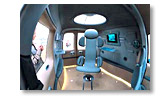

For the Renault Pangea is a mobile multimedia laboratory, equipped with the most sophisticated technology and able to conduct environmental research while maintaining contact with the entire planet: thus the single continent is recomposed, virtually, within a few square metres.
The ‘heart’ of the Renault Pangea is in fact the rear compartment: a research laboratory prepared with the aid of Philips Design, and consisting of two work stations one in front of the other. A seat, which moves on rails fixed to the floor, enables operation at either station and travels to the front-passenger position.
The passenger/research worker can take notes thanks to a small microphone that enables him to write by simply dictating to the on-board computer. Four spotlights at the corners of the cabin, fluorescent tubes, recessed mini-spots in the floor and the small instruments carefully aligned along the rack combine to create the aseptic atmosphere of a chemistry lab, further emphasised by the large empty areas and the subdued tones of the trim: an elegant contrast of grey and beige.
In observance of total environmental respect numerous details, such as carpets and dashboard, are in recycled materials.
Located at the centre of the roof is a perspex dome, replete with micro-camera. The pictures can be visualised either on the dashboard screen or the large central screen and may also be transmitted via satellite around the globe thanks to the antenna incorporated in the trailer.
As for the trailer, its function is to host the LPG gas turbine that powers the electric motor, located under the bonnet at the front. The mechanical set-up offers permanent all-wheel drive. It all began when Patrick Le Quément, chief of Renault design, met Stefano Marzano, senior director of Philips Design.
“Comparing our ideas on the philosophy of design, we identified the possibility of reciprocal interaction, working together in a well-defined research area, ” recalls Stefano Marzano. “We wondered what could be contributed by two companies operating in different sectors to generate product proposals with a chance of sustainable development.
Development that was positive at the ecological and human levels, achieved by combining two different skills: Renault with mobility; Philips with information technology – or more precisely multimedia, entertainment and communications.”
From here the vehicle concept came to life of a mobile ecology lab, perfect for the capillary control of the land, using computers to keep in contact with more stable laboratories. “Pangea stems from the encounter of two technologies that so far have travelled on parallel, but unconnected tracks. This synergy could generate new lifestyles, with a powerful impact on marketing the automotive product.”
To define the interior of the Pangea, the Philips and Renault designers met up in a series of workshops held in France and Holland. Departing from socio-cultural analyses and behavioural research, the basic concepts were visualised. The Philips-Renault team then maintained their close collaboration until the prototype construction stage (with bodywork built in Turin, by G Studio).
“For us it’s fundamental to observe lifestyles and behaviour patterns, which are assuming ever more stratified forms,” proceeds Marzano. “The use of computers, communications and entertainment technology is moving away from fixed spaces to mobile spaces. So it’s important to interact with the industry responsible for the mobility. The evolution of new in-car systems will involve everything related to safety – intended in a global sense – and will use networked contacts. The challenge consists in knowing how to apply the content of the working and domestic environments to a restricted environment like the car – with the greatest possible benefits for the end-user, of course.”
The article continues in Auto & Design no. 104










